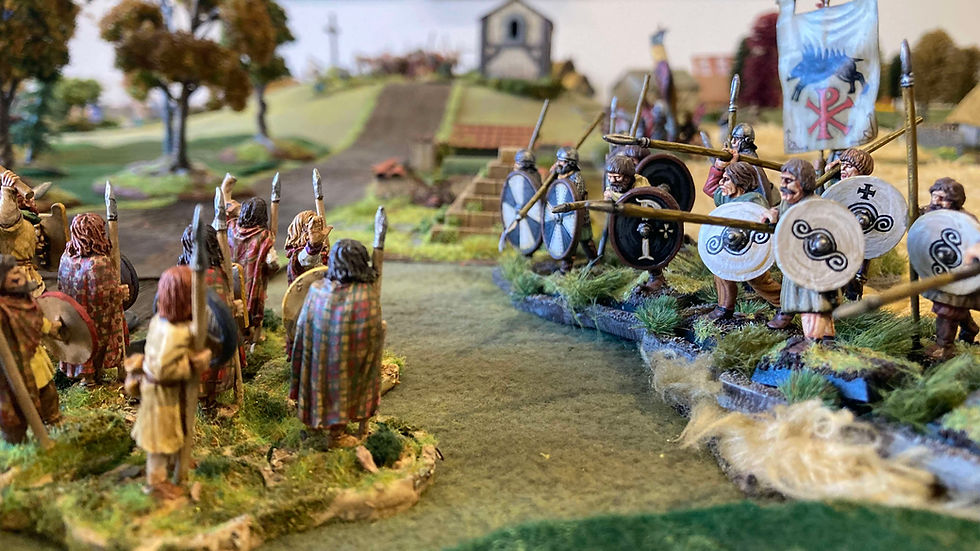A Hole in the Walls of Babylon
- Simon MacDowall
- Jan 19, 2023
- 3 min read
My 25mil Byzantine army has just its first table-top outing in more than 3 decades!

The game was set in early AD 1061 when most of Southern Italy was in Norman hands. As Robert Guiscard was planning to attack Arab-held Sicily, the Emperor Constantine X landed an Imperial army at Bari under the command of the Strategos Abulchares. The Byzantines recovered several towns from the Normans and then besieged Melfi — Guiscard’s capital.

Guiscard marched to relive the siege of Melfi. We do not know what happened historically other than the Byzantines were driven off. Our game assumed that Abulchares turned his army to face the advancing Normans. The Normans were given a slight advantage in numbers and élan but they needed to force the Byzantines to withdraw whilst the latter only need to hold their ground and prevent a breakthrough.

The Norman left flank was weighted in the hope of achieving a breakthrough against the weaker of the two Byzantine cavalry wings. They advanced with great élan but very little caution, their line beginning to fall into disorder as they galloped towards the Byzantine horse archers. The latter shot off a volley and promptly evaded, their lancer supports riding up to meet the Norman charge and holding it.

Roger Brosso who commanded the first line of Norman cavalry, was killed in the ensuing melée. This spread panic amongst the ranks and the Normans retired in disorder. Things were looking up!

The other cavalry wing saw a lot of inconclusive skirmishing between the Byzantine Turcopoles and Saracens in Norman pay. Both sides kept their heavy cavalry back waiting for the right moment as light infantry hovered on the wings.

Back on the Norman left, Robert Guiscard personally led his second line against the Byzantine cavalry who had only just managed to reorder themselves after the previous engagement. As Anna Comnena so aptly wrote in the early 12th century: “A Frank (as the Byzantines called the Normans) on horseback is invincible, and would even make a hole in the walls of Babylon.” And so they did!

This time it was Marolos, the Byzantine commander of the right wing, who met his death and the Byzantine right collapsed. The Normans (Franks) had indeed torn a hole in the walls of Babylon!

With his right seriously exposed Nikephoros Karantenos, the Byzantine infantry commander, led his reserve of Varangians into the flank of the advancing Normans.

The Varangians saw off a unit of Norman sergeants but then went off in a wild pursuit leaving themselves disastrously exposed to a flank charge by Robert Guiscard’s household knights.

Now Sergius V of Naples (allied with the Normans) led his heavy cavalry forward to engage the Imperial cavalry on the Byzantine left. Personally inspiring the change he broke the Byzantine front line.

Until this point both sides had held back their infantry centres. Now the Normans advanced through their screen of archers and crossbowmen to engage the Byzantine spearmen backed up by archers. The Byzantine foot were wavering after witnessing the rout of both cavalry wings.

The Byzantine foot held firm at first but, with Robert Guiscard’s household bearing down on their right flank, they were doomed. The battle was over and it was a resounding Norman victory. Only Abulchares, the Byzantine commander in chief, with one unit of Imperial cavalry and the Turcopoles were able to escape. Southern Italy was once more in Norman hands.
It was a cracking game but I rather expect that my Byzantine army would have preferred to have remained safely in their box (behind the walls of Constantinople) rather than being slaughtered by the Franks.



Simon, it was a cracking game that looked superb due in huge part to the resplendent robes and fine armour worn by your veteran Byzantines. Unfortunately their fighting prowess didn't match the quality of their dress, i.e. on this occasion your dice throwing was nowhere near the standard of your recent and historical painting!
It was an excellent game, Simon, I thoroughly enjoyed it. On reflection I should have thrown the left wing commander into the fray and let him inspire the lads but I think by that stage everything was lost, at least our sacrifice allowed the CiC to escape.
On to Antioch.